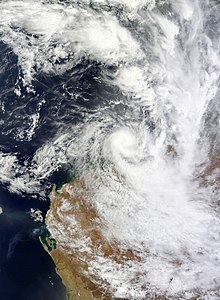Cyclone Heidi
 Heidi on January 11 | |
| Meteorological history | |
|---|---|
| Formed | 9 January 2012 |
| Dissipated | 13 January 2012 |
| Category 3 severe tropical cyclone | |
| 10-minute sustained (BOM) | |
| Highest winds | 150 km/h (90 mph) |
| Highest gusts | 205 km/h (125 mph) |
| Lowest pressure | 960 hPa (mbar); 28.35 inHg |
| Category 1-equivalent tropical cyclone | |
| 1-minute sustained (SSHWS/JTWC) | |
| Highest winds | 120 km/h (75 mph) |
| Lowest pressure | 974 hPa (mbar); 28.76 inHg |
| Overall effects | |
| Fatalities | None |
| Damage | Minor |
| Areas affected | Western Australia |
Part of the 2011–12 Australian region cyclone season | |
Severe Tropical Cyclone Heidi was a small and strong
In advance of Heidi's arrival, the Port of Port Hedland, offshore and coastal oil rigs and iron mines were shut and workers moved out of the area. Alerts were issued for much of the Pilbara coast, and the Port Hedland International Airport was shut. Heidi dropped heavy rainfall across the Pilbara and West Kimberley regions in Western Australia, with a maximum accumulation of 168.5 millimetres (6.63 in) being reported at Pardoo Station. These heavy rains lead to minor flooding on roads in the region. In addition, strong winds knocked out winds and caused major power outages in South Hedland and Wedgefield. Overall, Heidi caused only minor damage and no deaths; nonetheless, the name Heidi was later retired from the rotating list of storm names assigned by the Bureau of Meteorology.
Meteorological history

Tropical storm (39–73 mph, 63–118 km/h)
Category 1 (74–95 mph, 119–153 km/h)
Category 2 (96–110 mph, 154–177 km/h)
Category 3 (111–129 mph, 178–208 km/h)
Category 4 (130–156 mph, 209–251 km/h)
Category 5 (≥157 mph, ≥252 km/h)
Unknown
The origins of Heidi can be traced to a tropical low that was first noted by
Owing to the highly favourable environment and its small size, Heidi rapidly intensified after genesis. The system continued to track southwards while decelerating and contracting in size, and intensified to Category 2 strength six hours after being named. Heidi intensified into a Category 3 severe tropical cyclone at 1200 UTC on January 11, and six hours later attained its peak intensity with ten-minute sustained winds of 150 km/h (95 mph) and an estimated minimum central pressure of 960 mbar (hPa).[1] At the same time, the JTWC estimated Heidi to have one-minute sustained winds of 120 km/h (75 mph).[2] Heidi made landfall about 15 km (10 mi) east of Port Hedland a couple of hours later at peak intensity. At landfall, gale-force winds extended only 55 km (35 mi) outwards from the centre of the tropical cyclone. Heidi rapidly weakened over land: the cyclone fell to Category 2 strength within ten hours of landfall, and the system weakened to Category 1 strength in another six hours. Heidi weakened into a tropical low by 1800 UTC on January 12, which was last noted by TCWC Perth as well as the JTWC 12 hours later.[1][2]
Preparations and impact
In advance of the approach of Heidi, the BoM issued a cyclone warning for the coast from
The small, destructive core of Heidi missed Port Hedland to the east. Nonetheless, very strong winds and heavy rainfall caused minor flooding and power outages, and trees were uprooted across properties.[1] According to Horizon Power, more than 3,500 homes and businesses in Port Hedland lost power due to Heidi.[6] Though the threat of the storm surge did not eventuate as the storm slowed before landfall and as landfall occurred more than four hours after the high tide, heavy rainfall of over 100 mm (3.9 in) led to flooding in the region.[7] 168.5 mm (6.63 in) of rainfall was reported in 24 hours at Pardoo Station, while Port Hedland Aerodrome recorded 108.4 mm (4.27 in) of rain. Overall, damage due to Heidi was relatively minor, and no casualties were reported.[1]
The name Heidi was retired by the Bureau of Meteorology from the rotating list of names used for tropical cyclones in the Australian region following the season. It is replaced with Hayley.
See also
- Cyclone George (2007) – the last tropical cyclone to impact the Pilbara coast before Heidi.
- Cyclone Christine (2013) – impacted the Pilbara coast the following year.
References
- ^ Australian Bureau of Meteorology. Archived(PDF) from the original on 2019-01-07.
- ^ a b c Evans, Ashley J.; Falvey, Robert J. "Annual Tropical Cyclone Report 2012" (PDF). Joint Typhoon Warning Center. Archived (PDF) from the original on 2020-09-26. Retrieved 15 June 2021.
- ^ Evans, Nick (2012-01-11). "Cyclone Heidi shuts down mines, ports". PerthNow. Archived from the original on 2018-09-14. Retrieved 2021-06-15.
- ^ "Port Hedland braces for Cyclone Heidi - 9News". www.9news.com.au. Retrieved 2021-06-15.
- ^ "Port Hedland braces for Cyclone Heidi". The Sydney Morning Herald. 2012-01-11. Retrieved 2021-06-16.
- ^ a b "Clean-up begins in the wake of Cyclone Heidi". ABC News. 2012-01-12. Retrieved 2021-06-16.
- ^ Collins, Ben; Bannister, Brooke (13 January 2012). "Tropical Cyclone Heidi just another wet season in the Pilbara". Australian Broadcasting Corporation. Archived from the original on 2012-01-21. Retrieved 2021-06-16.

